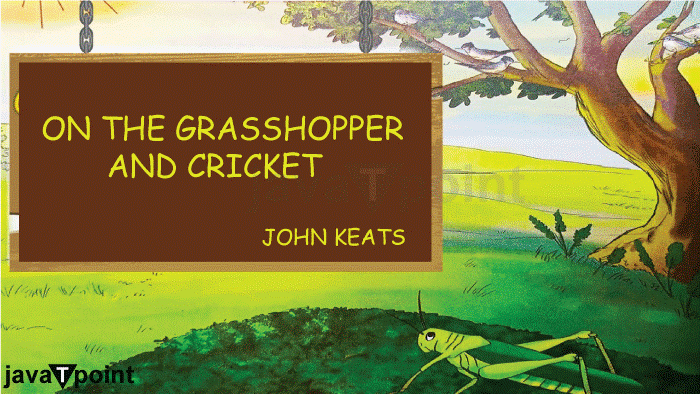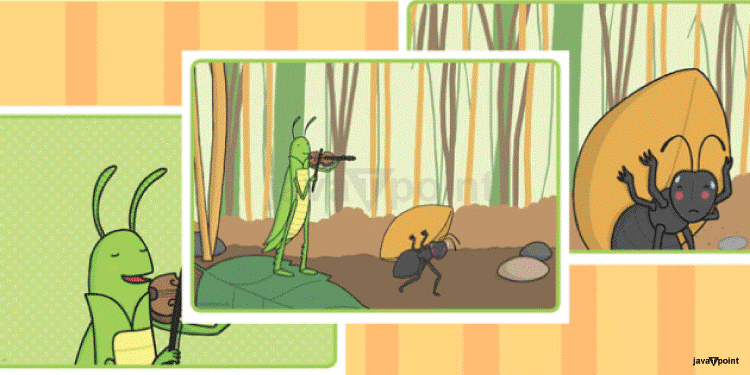On the Grasshopper and Cricket Summary Class 8 EnglishThe Central Board of Secondary Education (CBSE) book contains Class 8 poetry titled "On the Grasshopper and Cricket." John Keats penned it down. The summary of the poem is crucial from the perspective of the exam. After reading the summary, the student will feel confident and excel in the examination. It will help them to gain maximum marks. The summary is crisp and to the point; thus, it makes it time-saving and crucial material. Brief Introduction
The Grasshopper and the Cricket elaborately discuss nature's beauty and resilience. The poet has described his feeling through the poem. It is considered to be a fourteen-line poem. Usually, a fourteen-line of sonnet contains an octave and a sestet. Octave is two quatrains constructing up a stanza of 8 lines. A sestet is a stanza of six lines. It has been used as a meter of iambic pentameter and sticks to a set of rhyme schemes. Under these general rules, what makes a sonnet is a large variety of variations. Some of the common sonnet variations are English sonnets and Italian sonnets. The English sonnet is also called Shakespearean Sonnet, and Italian Sonnet is called Petrarchan Sonnet. Summary
The poem is about nature, and it is poetry that is eternal. The poem highlights both the season of summer and winter. The poem was penned by the renowned poet John Keats. The poet believes that poetry of nature never finishes when all the birds go into the trees to shield themselves from the scorching heat of intense summer. After taking shelter in the trees, the birds prohibit their singing. But nature does not stop singing. The grasshopper takes the lead from here, and the grasshopper can be observed enjoying the luxury of the sun. He takes forward the eternal song of nature. The grasshopper seems to be enjoying the singing in the summer. When the grasshopper runs out of energy, it subsides in the weed to rest. The poet continues that even the grasshopper goes into rest mode, but the song of nature never ceases. In the chilly winter, birds cease to sing in the frosty evening, and the cricket takes the lead. The cricket initiates singing the song and extends its warmth of happiness everywhere. People who are half asleep assume that it is the voice of the grasshopper which is emanating from the grassy hills. Although the poem conveys a message about nature's serenity and diversity, it teaches humans that we should also try to remain calm and happy. About the Author: John Keats
John Keats is an English Romantic poet born on 31 October 1795 in London. He was the oldest among his sibling, and his parents departed from the earth at a very early age in his life. His father, a livery stable keeper, departed from the earth when John Keats was eight. His mother demised due to tuberculosis after six-year. His maternal grandmother gave John Rowland Sandell and Richard Abbey the responsibility of guardian of John Keats. Abbey was a prosperous tea broker who took a massive part of the responsibility, and Sandell played an insignificant role. When Keats turned fifteen, Keats was withdrawn from Clarke School, Enfield, on the behest of Abbey and sent to apprentice for the apothecary surgeon and research on Study medicine in a London hospital. He became a licensed apothecary in 1868 but never practiced it and turned to writing. Leigh Hunt, a renowned editor of "The Examiner," met Keats around this period. Hunt helped Keats to get his sonnet "O Solitude" and "On First Looking into Chapman's Homer" published. Hunt was instrumental in making Keats familiarise himself with literary icons such as William Wordsworth and Percy Bysshe Shelley. Under the influence of this group, it allowed him to produce his first volume, Poems by John Keats, printed in 1817. Shelley, who was more impressed with the work of John Keats, suggested constructing a more substantial body of work before bringing it to the public. Keats did not like Shelly and did not act on his advice. He is a romantic poet famous for his perfection and extensive application of clear imagery. His poem is regarded as some of the finest works in literature.
Next TopicOrientalism Summary
|
 For Videos Join Our Youtube Channel: Join Now
For Videos Join Our Youtube Channel: Join Now
Feedback
- Send your Feedback to [email protected]
Help Others, Please Share









